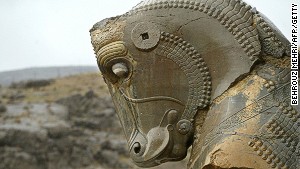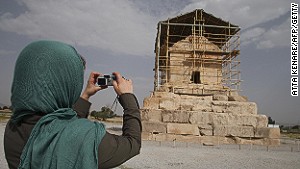This rare travel incident set the tone for the rest of my trip.
You wouldn't know it for
all the diplomatic sound and fury that surround the country, but
possibly the most exceptional thing about Iran compared with the other
Middle Eastern countries I've been to
-- and I've visited them all, as a
roving travel correspondent and Middle East specialist -- is how almost
manically welcoming everyone is.
Other than that, its
extraordinary archaeological wealth, palaces dripping with former regal
indulgence, elaborate Islamic gardens and urban skylines bristling with
minarets deserve to place it alongside Turkey and Dubai on the
international tourist circuit.
Whether the election of
Hassan Rouhani to the presidency earlier this month will spur more
travel to the country remains to be seen, but his moderate political
stance at home and abroad at least bodes well for tourism.

Sculpture in the ancient Persian city of Persepolis.
Sharia immersion
Sure, there are things you might not be used to in Iran.
The country follows Sharia law, of course, but it's not as sinister as some people think.
Women must cover their
heads with a shawl (including in the photo they send in with their visa
application) and alcohol is prohibited.
But most of the obstacles to travel in Iran arise before you get there.
No doubt your
acquaintances will try to put you off, for a start, made wary by the
overwhelmingly tense news that emanates from the country.
Tourist visas, too, can take up to a month to obtain.
On the bright side, most are -- eventually -- issued without question.
Then there are the
typically dire but, in my experience, exaggerated Western government
travel advisories on the country. Curiously, while Britain advises
"against all travel" to Iran, the U.S. State Department merely suggests
its citizens "carefully consider the risks" of a trip.
Those ultra-cautious
advisories, like an overprotective aunt, also risk invalidating your
travel insurance -- so be sure to check the fine print of your policy if
you have one.
But perhaps the greatest
risk of visiting this member of the former "axis of evil," as George W.
Bush memorably described it, is being profiled by your own government.
Zoroastrian fire temple
Am I putting you off yet?
Well, let's consider
what you'll miss out on if you don't one day slot Iran into your travel
itinerary: most travelers who do take the plunge come away raving about
the place.
Among the highlights of
my recent visit was the Zoroastrian fire temple in the city of Yazd,
whose flame is said to have burned since 470 AD.
Nearby, I climbed to the
hilltop Tower of Silence, where the Zoroastrian dead were picked clean
by vultures to avoid contaminating the earth right up until the 1960s.
Then there's the National Jewels Museum
(Ferdowsi Avenue; +98 21 6446 3785) in Tehran -- where most travelers
start their Iranian trip -- located in a vault beneath the Central Bank
of Iran. Among its treasures are the 182-carat Darya-e Nur diamond, so
chunky and iridescent it virtually constitutes its own light source.
There, too, you'll find
the emerald, sapphire and pearl-studded Peacock Throne, stolen by one of
the shahs from a Mughal emperor.
Fancy a further glimpse
of Iran before the January 1979 Islamic Revolution, which sent the last
shah into exile and turned the country into one of the West's biggest
bad boys?
There's the grand Golestan, Niyavaran and Sa'd Abad palaces, unchanged since that seismic political event.
They're all worth visiting.
What you won't find in
Tehran are surly crowds chanting anti-Western slogans or hustlers
similar to those cruising the streets of Cairo and Istanbul.
Imam Square
Isfahan is the next stop
on many Iran itineraries, with its Imam Square said to be the second
largest such urban space in the world after Tiananmen in Beijing.
Facing this immodest
expanse are the gloriously tiled Lotfollah and Shah mosques, the
seven-story Ali-Qapu Palace and the entrance portal to the huge Bozorg
Bazaar.
Nearby, the 16th- and 17th-century frescoes of the Chehel Sotun Palace are alive with color and incident.
Frescoes also illuminate
the Vank Armenian Cathedral south of the Zayandeh River, itself crossed
by three massive 17th-century stone bridges.
In Shiraz, in
south-central Iran, wine production may have dried up but some of the
finest gardens, historic homes, mosques and markets in the country
remain.
Most people stop by
Shiraz en route to ancient Persepolis, less than an hour to the
northeast. The ruins of this ancient Persian capital, built by Darius
the Great in 520 BC and sacked by the equally great Alexander 200 years
later, were buried under sand until the 1930s and are well preserved.

Limestone tomb of ancient Persia's King Cyrus the Great, near the modern city of Shiraz.
Darius and Xerxes
A short drive from
Persepolis is Naqsh-e Rostam, with the cliff tombs of the Persian kings
Darius I and II, Xerxes and Artaxerxes.
Finally, Yazd, on the
Silk Road toward Central Asia, has one of the largest and best preserved
medieval quarters in the Middle East. The portal of Jame Mosque (1324)
is the highest in the country with towering twin minarets, a hallmark of
the Shia faction of Islam.
There, again, is that eerie Zoroastrian fire temple, with its apparently unquenchable flame.
These sights stay with
you as markers of a great, enduring civilization. But perhaps the most
enduring memory is how universally friendly ordinary Iranians are.
In a world in which
jaded attitudes about tourists reach from Tenerife to Timbuktu, it may
take a while before it stops feeling strange.
David Stanley has written guidebooks for Lonely Planet and Moon Handbooks.
http://travel.cnn.com
By David Stanley, for CNN

No comments:
Post a Comment